Magnetoviscosity of a Magnetic Fluid Based on Barium Hexaferrite Nanoplates
Abstract
:1. Introduction
2. Materials and Methods
2.1. Nanoparticles and Magnetic Fluid
2.2. Rheometric Measurements
3. Results and Discussion
3.1. Magnetoviscous Effect
3.2. Yield Stress
3.3. Concluding Remarks
Author Contributions
Funding
Institutional Review Board Statement
Informed Consent Statement
Data Availability Statement
Acknowledgments
Conflicts of Interest
Abbreviations
| MF | Magnetic fluid |
| MVE | Magnetoviscous effect |
References
- Odenbach, S. Magnetoviscous Effects in Ferrofluids; Springer: Berlin/Heidelberg, Germany, 2002. [Google Scholar]
- Genc, S.; Derin, B. Synthesis and rheology of ferrofluids: A review. Curr. Opin. Chem. Eng. 2014, 3, 118–124. [Google Scholar] [CrossRef]
- Odenbach, S. Microstructure and rheology of magnetic hybrid materials. Arch. Appl. Mech. 2016, 86, 269–279. [Google Scholar] [CrossRef]
- Ivanov, A.; Zubarev, A. Chain Formation and Phase Separation in Ferrofluids: The Influence on Viscous Properties. Materials 2020, 13, 3956. [Google Scholar] [CrossRef] [PubMed]
- Andò, B.; Baglio, S.; Beninato, A. Magnetic Fluids for Bio-medical Application. In Advances in Biomedical Sensing, Measurements, Instrumentation and Systems; Lecture Notes in Electrical Engineering; Mukhopadhyay, S.C., Lay-Ekuakille, A., Eds.; Springer: Berlin/Heidelberg, Germany, 2010; Volume 55. [Google Scholar]
- Odenbach, S. Ferrofluids and their applications. MRS Bull. 2013, 38, 921–924. [Google Scholar] [CrossRef]
- Yang, R.-J.; Hou, H.-H.; Wang, Y.-N.; Fu, L.-M. Micro-magnetofluidics in microfluidic systems: A review. Sens. Actuators B Chem. 2016, 224, 1–15. [Google Scholar] [CrossRef]
- Pelaz, B.; Alexiou, C.; Alvarez-Puebla, R.A.; Alves, F.; Andrews, A.M.; Ashraf, S.; Balogh, L.P.; Ballerini, L.; Bestetti, A.; Brendel, C.; et al. Diverse applications of nanomedicine. ACS Nano 2017, 11, 2313–2381. [Google Scholar] [CrossRef] [Green Version]
- Larson, R.G. The Structure and Rheology of Complex Fluids; Oxford University Press: New York, NY, USA, 1999. [Google Scholar]
- Shahnazian, H.; Graf, D.; Borin, D.; Odenbach, S. Rheology of a ferrofluid based on nanodisc cobalt particles. J. Phys. D Appl. Phys. 2009, 42, 205004. [Google Scholar] [CrossRef]
- Lopez-Lopez, M.T.; Gomez-Ramirez, A.; Rodriguez-Arco, L.; Duran, J.D.G.; Iskakova, L.; Zubarev, A. Colloids on the Frontier of Ferrofluids. Rheological Properties. Langmuir 2012, 28, 6232. [Google Scholar] [CrossRef]
- Gautam, N.; Thirupathi, G.; Singh, R. Magnetoviscosity of Paraffin-Based Barium Ferrite Ferrofluid. IEEE Trans. Magn. 2016, 52, 4600204. [Google Scholar] [CrossRef]
- Müller, R.; Hiergeist, R.; Steinmetz, H.; Auyob, N.; Fujisaki, M.; Schüppel, W. Barium hexaferrite ferrofluids—Preparation and physical properties. J. Magn. Magn. Mater. 1999, 201, 34–37. [Google Scholar] [CrossRef]
- Gautam, N.; Singh, R. Magneto-viscosity of stable colloidal solutions of Barium-strontium hexaferrite ferrofluid. Mater. Res. Express 2019, 6, 084012. [Google Scholar] [CrossRef]
- Shirk, B.T.; Buessem, W.R. Magnetic properties of barium ferrite formed by crystallization of a glass. J. Am. Ceram. Soc. 1970, 53, 192–196. [Google Scholar] [CrossRef]
- Kojima, H. Fundamental properties of hexagonal ferrites with magnetoplumbite structure. In Handbook of Ferromagnetic Materials; Wohlfarth, E.P., Ed.; Elsevier: Amsterdam, The Netherlands, 1982; Volume 3, pp. 305–393. [Google Scholar]
- Müller, R.; Hiergeist, R.; Gawalek, W.; Hoell, A.; Wiedenmann, A. Magnetic and structural investigations on barium hexaferrite ferrofluids. J. Magn. Magn. Mater. 2002, 252, 43–45. [Google Scholar] [CrossRef]
- Müller, R.; Hergt, R.; Dutz, S.; Zeisberger, M.; Gawalek, W. Nanocrystalline iron oxide and Ba ferrite particles in the superparamagnetism-ferromagnetism transition range with ferrofluid applications. J. Phys. Condens. Matter 2006, 18, S2527–S2542. [Google Scholar] [CrossRef] [Green Version]
- Primc, D.; Makovec, D.; Lisjak, D.; Drofenik, M. Hydrothermal synthesis of ultrafine barium hexaferrite nanoparticles and the preparation of their stable suspensions. Nanotechnology 2009, 20, 315605. [Google Scholar] [CrossRef]
- Drofenik, M.; Ban, I.; Makovec, D.; Žnidaršič, A.; Jagličić, Z.; Hanžel, D.; Lisjak, D. The hydrothermal synthesis of super-paramagnetic barium hexaferrite particles. Mater. Chem. Phys. 2011, 127, 415–419. [Google Scholar] [CrossRef]
- Hribar Boštjančič, P.; Tomšič, M.; Jamnik, A.; Lisjak, D.; Mertelj, A. Electrostatic Interactions between Barium Hexaferrite Nanoplatelets in Alcohol Suspensions. J. Phys. Chem. C 2019, 123, 23272–23279. [Google Scholar] [CrossRef] [Green Version]
- Dudziak, S.; Ryżyńska, Z.; Bielan, Z.; Ryl, J.; Klimczuk, T.; Zielińska-Jurek, A. Pseudo-superparamagnetic behaviour of barium hexaferrite particles. RSC Adv. 2020, 10, 18784. [Google Scholar] [CrossRef]
- Shahnazian, H.; Odenbach, S. New driving unit for the direct measurement of yield stress with a stress controlled rheometer. Appl. Rheol. 2008, 18, 54974. [Google Scholar] [CrossRef]
- Rosensweig, R. Ferrohydrodynamics; Cambridge University Press: Cambridge, NY, USA, 1985. [Google Scholar]
- Linke, J.; Odenbach, S. Anisotropy of the magnetoviscous effect in a ferrofluid with weakly interacting magnetite nanoparticles. J. Phys. Condens. Matter 2015, 27, 176001. [Google Scholar] [CrossRef]
- Borin, D.Y.; Korolev, V.V.; Ramazanova, A.G.; Odenbach, S.; Balmasova, O.V.; Yashkova, V.I.; Korolev, D.V. Magnetoviscous effect in ferrofluids with different dispersion media. J. Magn. Magn. Mater. 2016, 416, 110–116. [Google Scholar] [CrossRef]
- Borin, D.Y.; Odenbach, S. Magnetic measurements on frozen ferrofluids as a method for estimating the magnetoviscous effect. J. Phys. Condens. Matter 2009, 21, 246002. [Google Scholar] [CrossRef] [PubMed]
- Borin, D.Y.; Odenbach, S. Rheology of novel ferrofluids. Int. J. Mod. Phys. B 2011, 25, 963–969. [Google Scholar] [CrossRef]
- Borin, D.; Zubarev, A.; Chirikov, D.; Müller, R.; Odenbach, S. Ferrofluid with clustered iron nanoparticles: Slow relaxation of rheological properties under joint action of shear flow and magnetic field. J. Magn. Magn. Mater. 2011, 323, 1273–1277. [Google Scholar] [CrossRef]
- Masoud Hosseini, S.; Vafajoo, L.; Ghasemi, E.; Salman, B.H. Experimental investigation the effect of nanoparticle concentrationon the rheological behavior of paraffin-based nickel ferrofluid. Int. J. Heat Mass Transf. 2016, 93, 228–234. [Google Scholar] [CrossRef]
- Shahnazian, H.; Odenbach, S. Rheological investigations of ferrofluids with a shear stress controlled rheometer. J. Phys. Condens. Matter 2008, 20, 204137. [Google Scholar] [CrossRef]
- Zubarev, A.Y.; Iskakova, L.Y. Yield stress in thin layers of ferrofluids. Phys. A 2006, 365, 265–281. [Google Scholar] [CrossRef]
- Shahnazian, H. Schubspannungsgesteuerte Rheologische Untersuchungen an Ferrofluiden. Ph.D. Thesis, Technische Universität Dresden, Dresden, Germany, 2009. [Google Scholar]
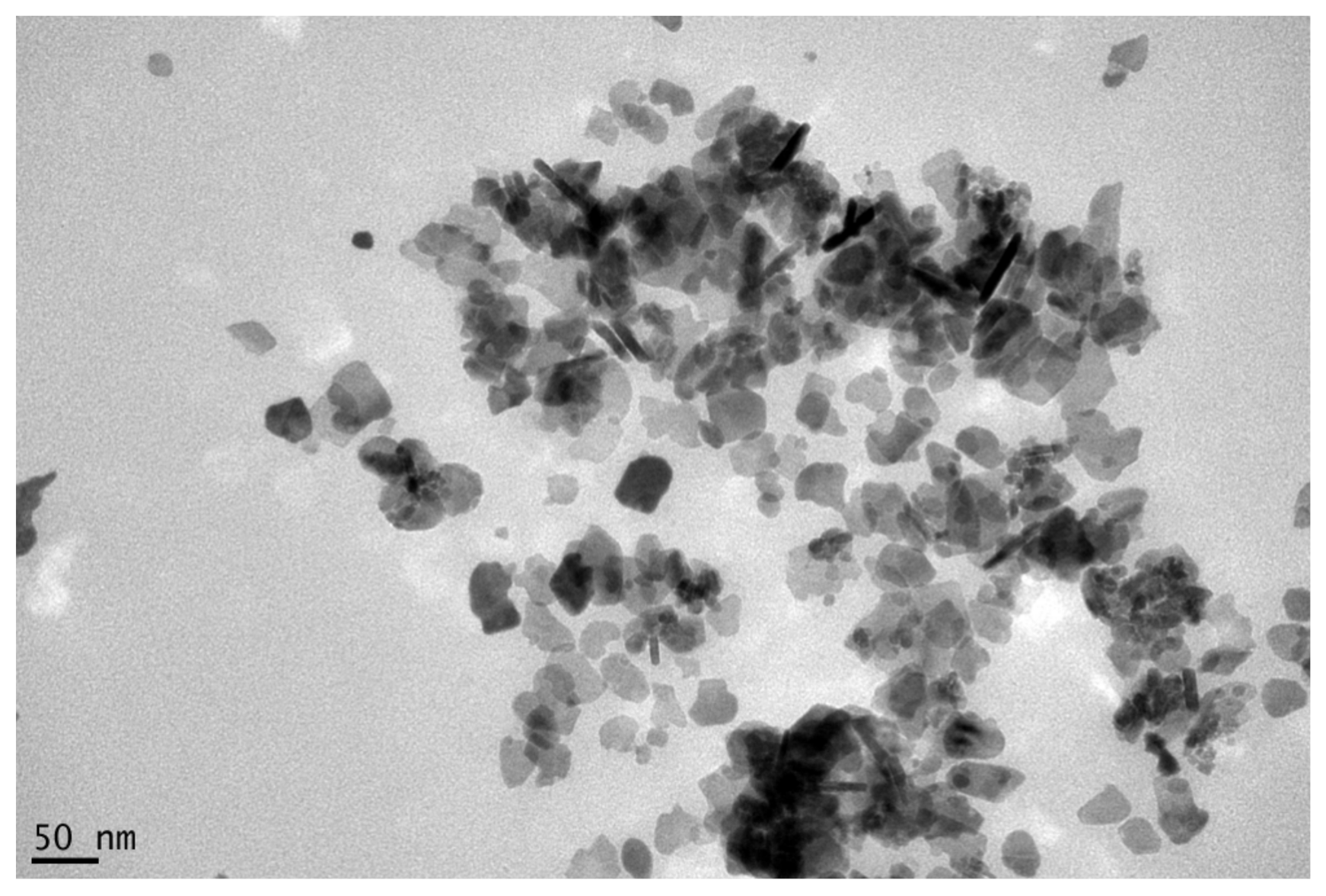
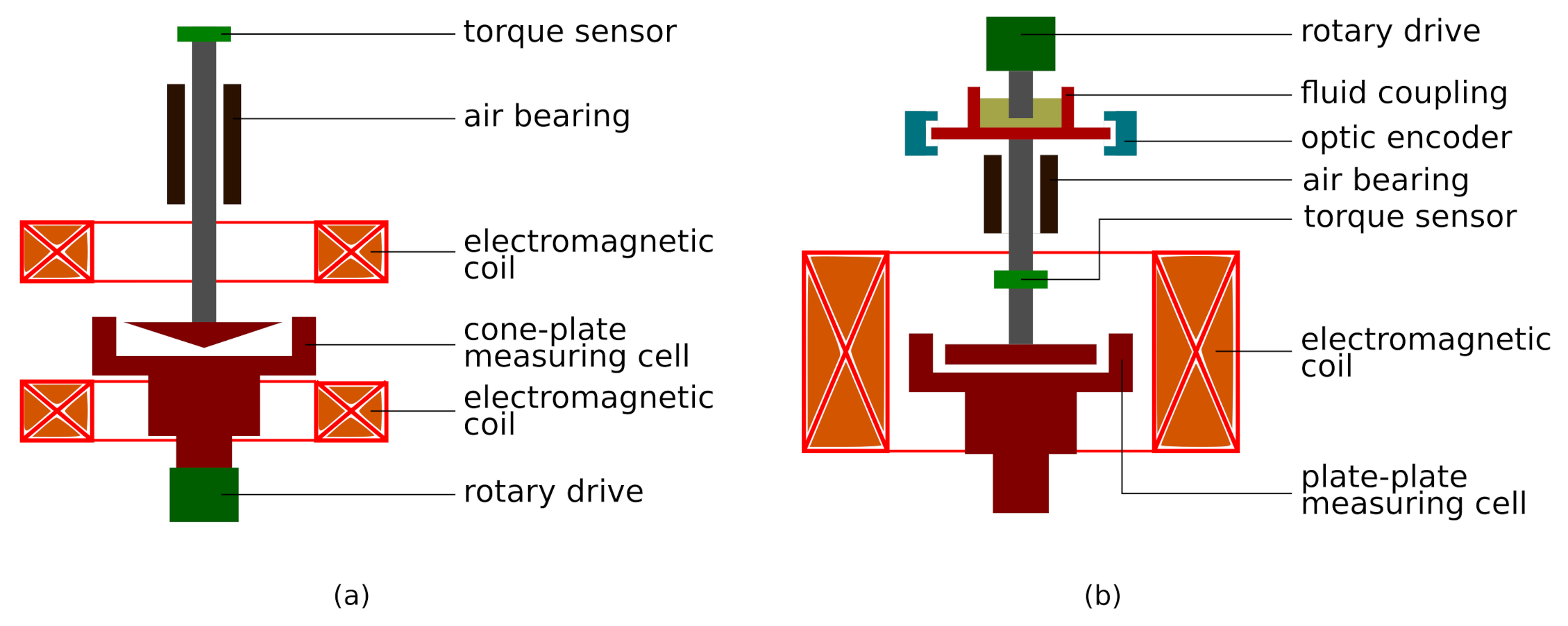

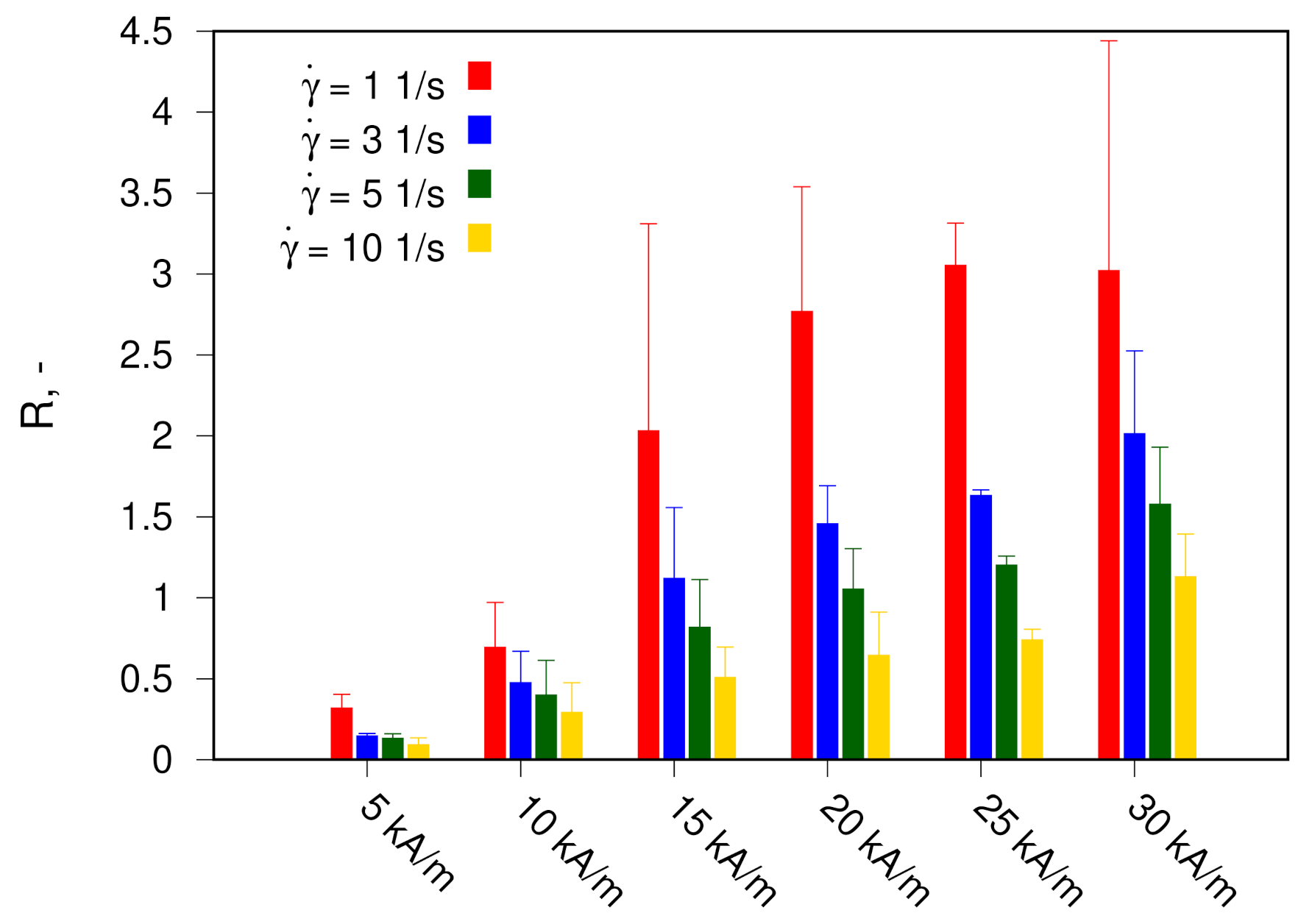
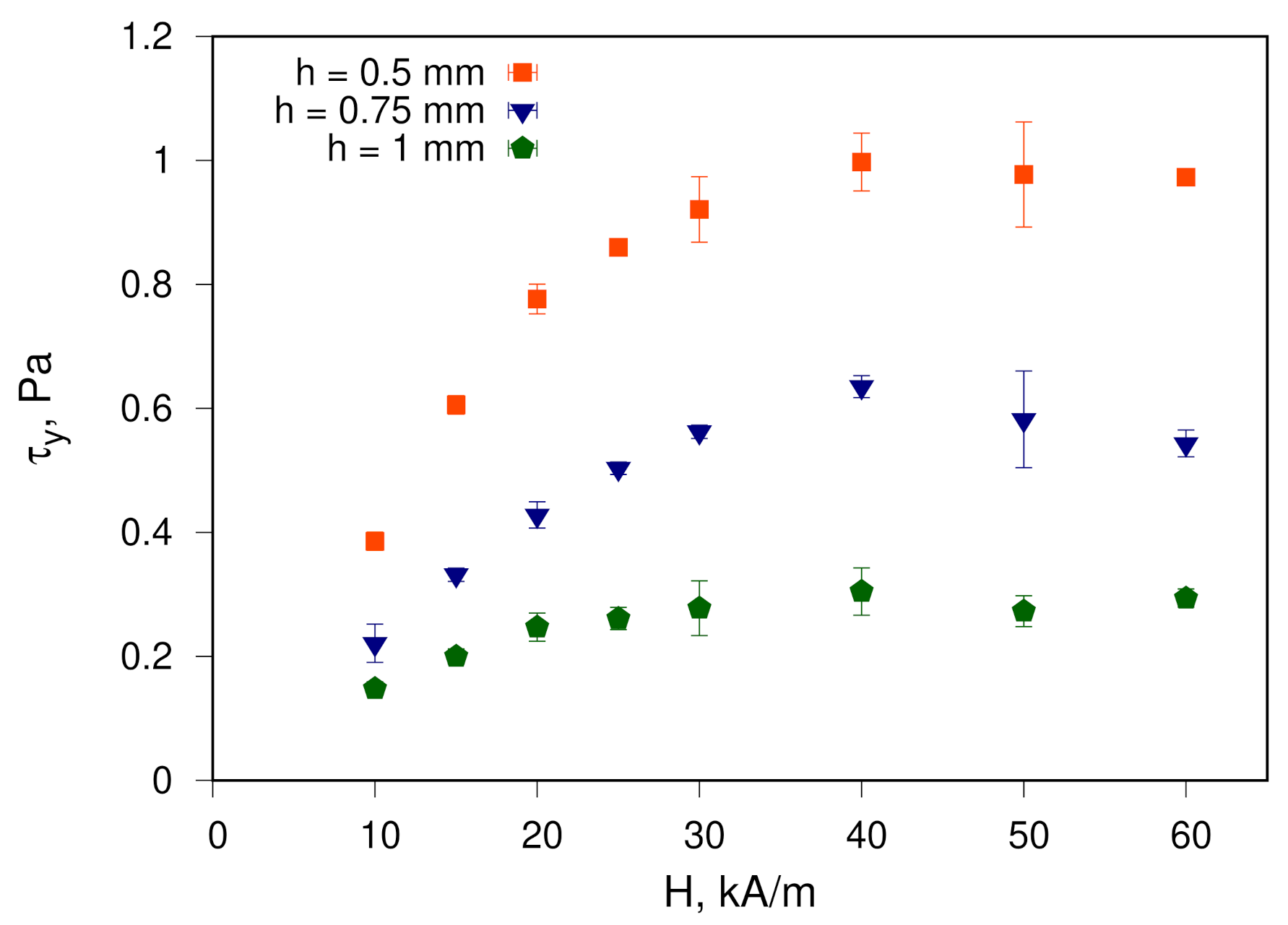
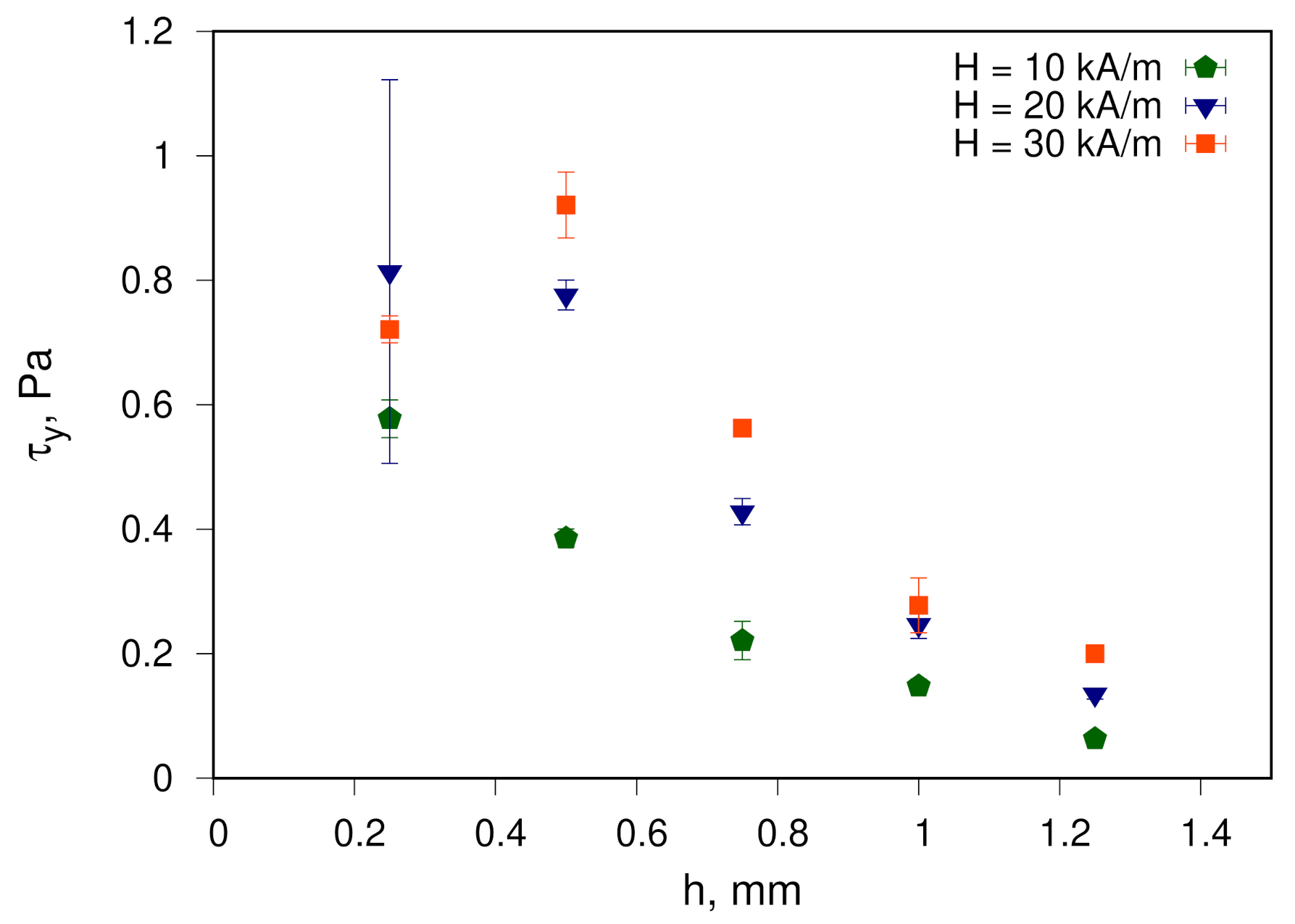
| # | Carrier Liquid | Nanoparticles | max. | , 1/s | H, kA/m | max. | Ref. | ||
|---|---|---|---|---|---|---|---|---|---|
| Type | Shape | Size | , % | MVE | |||||
| 1 | synthetic ester | spheres | ∼13 nm | 6.3 vol. | 0.5 | 5–50 | ∼2 | [25] | |
| 2 | polyethylsiloxane | spheres | ∼7.5 nm | 3.6 vol. | 100 | 10–100 | ∼0.2–2.2 | [26] | |
| 3 | silicon oil DC 702 | -based | spheres | ∼8 nm | 2.8 vol. | 0.3 | 5–30 | ∼2–30 | [27] |
| 4 | n-cetane | -based | plates | 5 × 20 nm | 0.1 vol. | ∼2.5 | 5 | ∼20 | [10,28] |
| 5 | mineral oil P3 | clusters | 50–70 nm | 0.1 vol. | 0.2–2 | 10–30 | ∼0.6–60 | [29] | |
| 6 | paraffin | clusters | 175–350 nm | 40 wt. | 5 | 5–90 | ∼0.2–9.5 | [30] | |
| 7 | mineral oil P3 | -based | plates | 4 × 35 nm | 4.7 vol. | 1–10 | 5-30 | ∼0.3–3 | this study |
Publisher’s Note: MDPI stays neutral with regard to jurisdictional claims in published maps and institutional affiliations. |
© 2021 by the authors. Licensee MDPI, Basel, Switzerland. This article is an open access article distributed under the terms and conditions of the Creative Commons Attribution (CC BY) license (https://creativecommons.org/licenses/by/4.0/).
Share and Cite
Borin, D.; Müller, R.; Odenbach, S. Magnetoviscosity of a Magnetic Fluid Based on Barium Hexaferrite Nanoplates. Materials 2021, 14, 1870. https://doi.org/10.3390/ma14081870
Borin D, Müller R, Odenbach S. Magnetoviscosity of a Magnetic Fluid Based on Barium Hexaferrite Nanoplates. Materials. 2021; 14(8):1870. https://doi.org/10.3390/ma14081870
Chicago/Turabian StyleBorin, Dmitry, Robert Müller, and Stefan Odenbach. 2021. "Magnetoviscosity of a Magnetic Fluid Based on Barium Hexaferrite Nanoplates" Materials 14, no. 8: 1870. https://doi.org/10.3390/ma14081870






